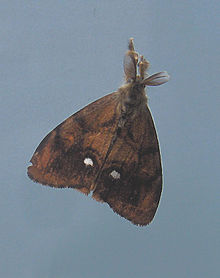Genus of moths
Orgyia tussock moths of the family Erebidae . The genus was described by Ochsenheimer in 1810. The species are cosmopolitan , except for the Neotropical realm .[ 1] [ 2] [ 3]
Orgyia sp.
Description
The male flies during the day. Its palpi are short, porrect (extending forward), and heavily fringed with hair. The antennae have long branches and long spines at the extremities. The legs are heavily hairy. The abdomen has a dorsal tuft on its second segment. The forewing has vein 9 arising from vein 10 and anastomosing with vein 8 to form an areole. The hindwing has veins 3 and 4 from angle of cell, vein 5 from just above angle, and vein 6 and 7 stalked.
In the female, the palpi and legs are less hairy. The antennae are serrate. The wings are aborted, scale-like and covered with hair. The abdomen is covered with hair and immensely dilated when full of eggs .[ 4]
Species
Orgyia albofasciata (Schintlmeister, 1994) Orgyia amphideta (Turner, 1902) Orgyia antiqua (Linnaeus, 1758) – rusty tussock moth, vapourer mothOrgyia araea (Collenette, 1932) Orgyia ariadne (Schintlmeister, 1994) Orgyia australis Walker, 1855 Orgyia basinigra (Heylaerts, 1892) Orgyia cana H. Edwards, 1881 Orgyia chionitis (Turner, 1902) Orgyia definita Packard, [1865] – definite tussock mothOrgyia detrita Guérin-Méneville, [1832] – fir tussock mothOrgyia dewara Swinhoe, 1903 Orgyia falcata Schaus, 1896 Orgyia fulviceps (Walker, 1855) Orgyia leptotypa (Turner, 1904) Orgyia leucostigma (Smith, 1797) – white-marked tussock mothOrgyia leuschneri Riotte, 1972 Orgyia magna Ferguson, 1978 Orgyia osseana Walker, 1862 Orgyia papuana Riotte, 1976 Orgyia pelodes (Lower, 1893) Orgyia postica (Walker, 1855) Orgyia pseudotsugata (McDunnough, 1921) – Douglas-fir tussock mothOrgyia semiochrea (Herrich-Schäffer, [1855]) Orgyia thyellina Butler, 1881 Orgyia vetusta Boisduval, 1852 – western tussock mothOrgyia viridescens (Walker, 1855)
References
Wikimedia Commons has media related to
Orgyia .
^ Savela, Markku (July 5, 2019). "Orgyia Ochsenheimer, 1810" . Lepidoptera and Some Other Life Forms . Retrieved May 16, 2020 . ^ Beccaloni, G.; Scoble, M.; Kitching, I.; Simonsen, T.; Robinson, G.; Pitkin, B.; Hine, A.; Lyal, C., eds. (2003). "Orgyia " . The Global Lepidoptera Names Index Natural History Museum . Retrieved May 16, 2020 . ^ Pitkin, Brian & Jenkins, Paul (November 5, 2004). "Orgyia Ochsenheimer, 1810" . Butterflies and Moths of the World . Natural History Museum, London . Retrieved May 16, 2020 . ^ Hampson, G. F. (1892). The Fauna of British India, Including Ceylon and Burma: Moths Volume I public domain .

